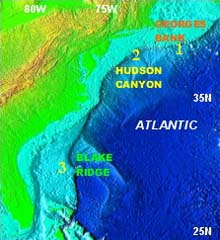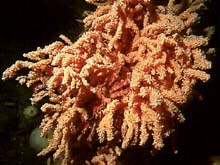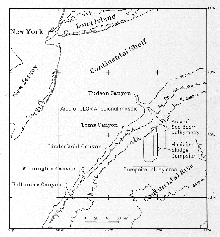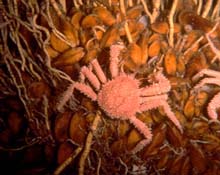
The Deep East Expedition will include three legs and dives at (1) the Georges Bank canyons and Bear Seamount, (2) Hudson Canyon, and (3) Blake Ridge.
Mission Plan
Need for the Expedition
Exploration and discovery are insurance for personal, economic and ecological health. These factors drive the push to frontier areas, whether on land, in space, or under the sea. The calculated value of resources in the sea is many orders of magnitudes greater than that which we have mined and captured to date. The premise behind the Stratton Commission -- an ocean policy commission that operated in 1969 -- was to tap this vast wealth. Thirty years later, we remain with most of the oceans unexplored, yet with new technologies and understanding that bring the frontier closer.
Three regional centers in NOAA’s National Undersea Research Program will partner in 2001 to coordinate Deep East, a Voyage of Discovery exploring new resources and deep-sea frontiers off the U.S. East Coast. The deep submergence vehicle Alvin, America's only occupied submersible capable of diving below 2,000 m, will be used to document and sample submarine canyons, a seamount, and deep slope features from New England to Georgia.
LEG ONE: Deep Sea Coral Communities in the Georges Bank Canyons
Sept. 8-9, in port at Woods Hole, MA; Sept. 10-14, dives
Science Team: Les Watling, University of Maine; Kevin Eckelbarger, University of Maine; Peter Auster, University of Connecticut; Barbara Hecker, Hecker Associates.

Octocoral Primnoa resedaeformis lives in the deep sea of the North Atlantic. Click image for larger view.
Deep-water corals, such as the octocoral Primnoa resedaeformis and gorgonian Paragorgia arborea, are common inhabitants of the upper and middle slope faunas in the canyons south of Georges Bank. Little is known about their biology, population status, the role they play in enhancing local species diversity, and their role as habitat for deep-water fishes, including several commercial species. Recent submersible dives suggest that the distribution of corals has significantly declined in the past three decades, likely destroyed by trawling and dragging.
The overall goal of Leg 1 is to characterize deep-water octocoral communities of the Georges Bank Canyons and on Bear Seamount. Specific objectives include:
• assessing the diversity of coral communities in different canyon habitats, on Bear Seamount, and in the Gulf of Maine;
• determining whether coral populations are capable of reproduction by analyzing individual coral polyps;
• determining the size/class distribution of octocoral populations;
• describing patterns of coral habitat use by associated fauna; and
• verifying the taxonomy and genetic similarity of coral species from the continental slope off Georges Bank and on Bear Seamount.
LEG TWO: Deep Sea Processes and Resources in Hudson Submarine Canyon
Sept. 15-19, dives; Sept. 20-21, in port at New York City
Science Team: Fred Grassle, Rutgers University; Peter Rona, Rutgers University; Mike Bothner, U.S. Geological Survey; Mary Scranton, SUNY/Stony Brook.

Chart showing the location of the DWD-106 sewage sludge dumpsite southwest of Hudson Canyon. Click image for larger view.
Hudson Submarine Canyon, an ancient extension of the Hudson River Valley, extends over 400 nautical miles seaward from the New York-New Jersey Harbor, and is the largest submarine canyon on the U.S. East Coast. Like all submarine canyons, it is a conduit for the transport of sediments, nutrients, and pollutants between land and the deep sea. The canyon also hosts a remarkable diversity of deep-sea life. On the flank of the canyon, the DWD-106-mile sewage sludge dumpsite received the world’s largest discharge of municipal sewage sludge to the deep sea from 1986-1992. In 1989, results from Alvin dives showed unexpected chemical increases and biological changes that finally stopped the dumping. The flanks of the canyon are very unstable and susceptible to mass slumping. A bed of gas hydrates beneath the slope may contribute to this instability and provide methane that seeps up through the sediments and feeds an undescribed chemosynthetic community.
In 2001, the Hudson Canyon leg of the Deep East Expedition will focus on four primary exploration objectives:
• exploring deep-sea diversity in the Hudson Submarine Canyon;
• determining the fate and effects of past dumping activities at the DWD-106-mile site;
• exploring the processes governing the distribution and stability of gas-hydrate deposits; and
• exploring the potential occurrence of exotic communities associated with active methane venting from hydrate beds.
LEG 3: Gas Hydrates and Chemosynthetic Community on the Blake Ridge
Sept. 20-21, in port at New York City; Sept. 25-29, dives; Sept. 30-Oct. 1, in port at Charleston, SC
Science Team: Cindy Van Dover, College of William and Mary; Carolyn Ruppel, Georgia Tech University; Barun Sen Gupta, Louisiana State University; Joan Bernhard, University of South Carolina.

This deep-sea mussel, Bathymodiolus sp., lives near a chemosynthetic seep on the ocean floor. The symbiotic bacteria in its gills convert gas and hydrogen sulfide to carbon and energy. Click image for larger view.
Cold oil and gas seeps are common under the sea (methane leaking from a gas-hydrate bed is an example of a "cold seep"). Chemosynthetic communities similar to those found at hydrothermal vents inhabit these cold seeps, and use hydrocarbons or hydrogen sulfide for carbon and energy. Seep communities are ecologically important as sources of food and refuge for background slope species, and economically important as they mark underlying oil and gas resources. Extensive hydrate beds and associated cold seeps existing off the U.S. East Coast, such as the 3,000-sq-km bed beneath the Blake Ridge, may potentially be able to meet the nation’s gas-consumption needs for the next 30 yrs. During ocean-drilling activities that explored this bed in 1994, chemosynthetic mussels were discovered as part of the first cold-seep community found along the U.S. East Coast.
Leg 3 of the Deep East Expedition -- the first submersible exploration of a cold-seep chemosynthetic community off the U.S. East Coast -- will:
• describe the community associated with mussel beds at the Blake Ridge gas-hydrate seep site and map the diversity and extent of communities within this biologically unexplored hydrate field;
• describe geochemical conditions in and adjacent to the seep community; and
• correlate seep types and geochemical conditions to microbial assemblages.
NOAA's Partners
NOAA's partners in the Deep East Expedition include the National Undersea Research Centers (University of North Carolina at Wilmington, University of Connecticut, Rutgers University), the University of Maine, the College of William and Mary, Georgia Tech University, Louisiana State University, the University of South Carolina, the College of Charleston, the State University of New York at Stony Brook, the U.S. Geological Survey, Ecology Communications, and the Wildlife Conservation Society.
For a more detailed summary of Deep East, click here to download "Deep East 2001: Voyage of Discovery to Deep Sea Frontiers off the U.S. East Coast" (5 pages, PDF format, 368k)
Sign up for the Ocean Explorer E-mail Update List.
































